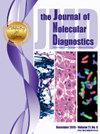利用数字多重连接法高通量多重检测大肠杆菌耐药基因和毒力因子。
IF 3.4
3区 医学
Q1 PATHOLOGY
引用次数: 0
摘要
大肠杆菌每年导致40万儿童死亡,其合成DNA的特异性和平衡准确性为99.9%。平衡准确性,计算为敏感性和特异性的平均值,解释了不平衡的数据集,其中负面结果明显比正面结果更普遍。dMLA对细菌分离物的平衡准确度达到90%。结果强调了dMLA在大肠杆菌耐药基因和毒力因子库的高通量表征中的有效性,利用测序同时在多个样品上大规模并行多路复用基因区域,并且可扩展到大肠杆菌以外的靶标。本文章由计算机程序翻译,如有差异,请以英文原文为准。
High-Throughput Multiplex Detection of Antibiotic-Resistant Genes and Virulence Factors in Escherichia coli Using Digital Multiplex Ligation Assay
Escherichia coli causes >400,000 annual deaths in children aged <5 years worldwide, with morbidity and mortality exacerbated by antimicrobial-resistant strains. A high-throughput multiplexing assay called digital multiplex ligation assay (dMLA) was developed to detect simultaneously 43 priority genes in E. coli related to the following: antibiotic resistance (n = 19), virulence factors (n = 16), and phylogroup markers (n = 6) with controls (uidA, gapdh). Genes are detected via PCR amplification of adjacent probe pairs that ligate in the presence of target gene-specific DNA, followed by sequencing of amplicons on short-read sequencers. The assay was tested in technical replicates on 63 synthetic DNA controls, and applied to 58 E. coli, 2 Staphylococcus aureus, 2 Klebsiella pneumoniae, 1 Klebsiella oxytoca, 1 Vibrio cholera, 1 Pseudomonas lurida, and 1 Salmonella enterica isolates in duplicate. Whole-genome sequencing was used to assess specificity and sensitivity. dMLA showed 100% sensitivity and >99.9% specificity and balanced accuracy on synthetic DNA. Balanced accuracy, calculated as the average of sensitivity and specificity, accounts for imbalanced data sets where negative outcomes are significantly more prevalent than positive ones. dMLA achieved a balanced accuracy of 90% for bacterial isolates. The results underline dMLA's effectiveness in high-throughput characterization of E. coli libraries for antimicrobial resistance genes and virulence factors, leveraging sequencing for massively parallel multiplexing of gene regions on multiple samples simultaneously, and are extendable to targets beyond E. coli.
求助全文
通过发布文献求助,成功后即可免费获取论文全文。
去求助
来源期刊
CiteScore
8.10
自引率
2.40%
发文量
143
审稿时长
43 days
期刊介绍:
The Journal of Molecular Diagnostics, the official publication of the Association for Molecular Pathology (AMP), co-owned by the American Society for Investigative Pathology (ASIP), seeks to publish high quality original papers on scientific advances in the translation and validation of molecular discoveries in medicine into the clinical diagnostic setting, and the description and application of technological advances in the field of molecular diagnostic medicine. The editors welcome for review articles that contain: novel discoveries or clinicopathologic correlations including studies in oncology, infectious diseases, inherited diseases, predisposition to disease, clinical informatics, or the description of polymorphisms linked to disease states or normal variations; the application of diagnostic methodologies in clinical trials; or the development of new or improved molecular methods which may be applied to diagnosis or monitoring of disease or disease predisposition.

 求助内容:
求助内容: 应助结果提醒方式:
应助结果提醒方式:


